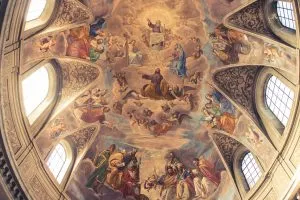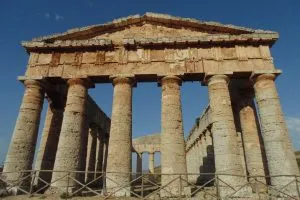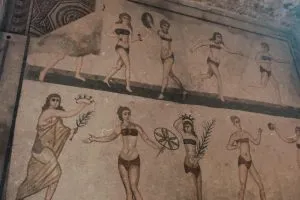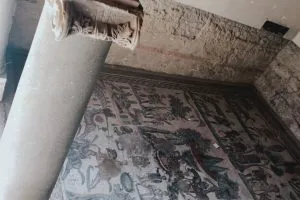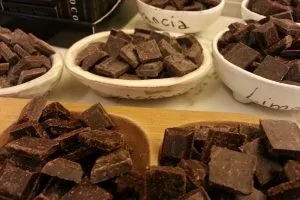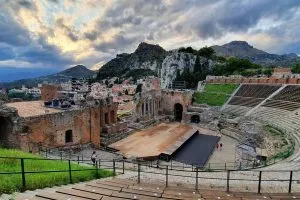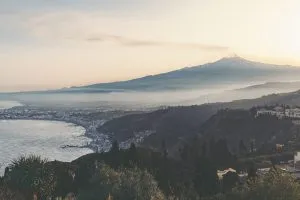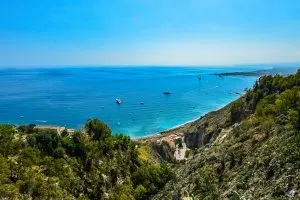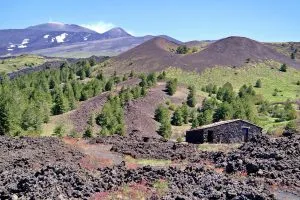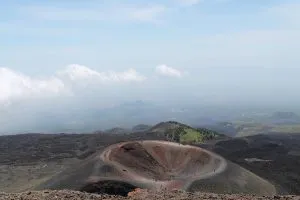Day 1
Arrival in Palermo
Welcome to the warm, beautiful and pleasant island of Sicily!
Upon arrival at Palermo Falcone-Borsellino Airport, please proceed through Passport Control and collect your luggage inside the customs area.
Our italian-speaking driver will be waiting for you at the arrival department.
Then transfer to your hotel.
Day 2
Full Day Palermo and Monreale
Start your tour of Palermo with a walking tour beginning at the Palermo Opera House and continue to the the Four Corners which is the junction in Palermo.
Effectively, it is the centre point of the four areas of the old town centre. You will almost inevitably pass through it and it is worth stopping for five minutes to have a look at its sculptures which were commissioned by the Spanish Viceroy in 1611. The sculptures on each of the four corners depict a variety of themes, including the four seasons, four Spanish kings and the four patron saints of the old town areas.
Going south-east down Via Maqueda you will come across Piazza Pretoria which is home not only to a splendid fountain but several other impressive buildings including, on the right, the City Hall.
The fountain, known for generations as the “Fountain of Shame”, has an interesting history. The large central fountain is the focal point for sixteen nude statues of nymphs, humans, mermaids and satyrs. If you imagine this being erected during the Inquisition, it is quite easy to imagine why it received its epithet, the “Fountain of Shame”.
Later to the Palatine Chapel, a UNESCO World Heritage Site, located inside the complex of Royal Palace. Its glittering gold mosaics, complemented by inlaid marble floors and wooden ceilings, reflect Arab-Norman Sicily's cultural complexity. Built by Roger II from 1130 to 1140, the chapel is adorned with extraordinary Norman-Byzantine mosaics.
This afternoon a short drive takes us to Monreale to see where Arab-Norman art and architecture reached its pinnacle in the Duomo, launched in 1174 by William II. It represents scenes from the Old and New Testaments all in golden mosaics.
We then return to Palermo.
Day 3
Segesta, Olive Oil Farm Lunch, Erice and Salt Way Road
Embark on a morning drive through western Sicily and view the famous Doric Temple of Segesta rising high on a hill, which was constructed in the 5th century B.C. and is one of the greatest examples of this Doric style of architecture.
Afterward, savor lunch with an olive oil tasting at a local farm.
Continue to the mountaintop Erice, a wonderfully preserved medieval town with breathtaking views and a great historical presence.
Walk along the cobbled streets lined with superb examples of Gothic, Baroque and Renaissance architecture. Wander through its ancient streets and visit some of the famous homemade pastry shops -- world-famous for marzipan candies and other delicacies like almond and pistachio pastries – and the lovely preserved Mediaeval town offering the most breathtaking views and a palpable sense of history. Then by walk we join the most visited sites: the Pepoli Castle and Venus Castle. The former was built by the Arabs while the latter was a Norman construction with imposing towers that derived its name from the fact that it was built on the site of the ancient Temple of Venus, allegedly founded by Aeneas.
We then travel from Erice to Trapani-Marsala Salt Way Road, skirting the lagoon to see the snow-capped mountains but hills of salt, one of the Sicilian economy's historical resources that was already very precious in the days of the Phoenicians, who were the first to bring some form of technology to its production.
The favorable climatic circumstances, such as high temperatures and a wind that increases evaporation, plus the shallowness of the water, contribute to create the evocative and unreal scenario created by the salt flats, which form a sort of immense chessboard that ranges in color from off-green to pink. The tourist paths for visits to the salt flats wind their way around the great basins and, running along the edges of the tanks of seawater - which glistens in the sun as it crystallizes - finally reach the mounds of salt. These mounds are topped by a series of recently restored windmills that recall the days when they were among the main instruments for pumping the water and grinding the salt. A panorama that has to be enjoyed, preferably at sunset, when everything becomes tinged with red.
The balance of the time is at leisure.
Day 4
Saltpans, Motya Charioteer and Winery
A short drive to the Marsala Saltpans which offer a truly unique landscape.
Windmills, first introduced during mediaeval times, dot the horizon, a testament to how things were once done, though one or two continue to function, pumping water through the sluice gates into or out of the various basins. Piles of harvested salt, neatly covered with terracotta tiles, lie between the road and the basins waiting to be despatched.
Then boarding your shuttle-boat to cruise on the Stagnone Lagoon to the island of Motya, an ancient trading outpost for Phoenician merchants. Here, you will see the beautiful and unique marble statue of the Motya Charioteer, a Greek influenced masterpiece dated back to the 5th century BC. It was found inside Phoenician fortifications, which were quickly erected before Dionysios I of Syracuse invaded and sacked Motya in 397 BC.
Lunch today is in Marsala Trattoria to taste local dishes.
This afternoon visit a local Winery to taste the Marsala Wine.
The Marsala is the oldest Italian DOC wine, with an average alcohol content of about 18 degrees. The aromatic and sugary richness of the grapes of Marsala is born from the method of growing them in a ‘sapling’ style, a very ancient method, dating back to the culture of vine itself.
Day 5
Mazara Kasbah Maze, Couscous and Selinunte Archaeological Park
This morning departure for Mazara.
At the northwest corner of the historic centre, this multicultural maze of narrow streets was once the heart of the Saracen city. The main thoroughfare was Via Bagno, which still has its hammam (public baths). Today the area is rundown but interesting, in large part because it retains a strong Arab connection through the Tunisian immigrants who now live here.
Enjoy a Couscous lunch topped with seafood and served with an intensely rich fish stock seasoned with cinnamon, bay leaves, and almonds, it’s one of Sicily’s most famous—and delicious—dishes.
Couscous has a long history in Sicily, specifically in Trapani area, a crescent-shaped province on the island’s western coast. The hours-long process of hand rolling durum wheat semolina with small amounts of water into grain-like pasta comes from North Africa, with origins most closely linked to Berber communities. Easy to make with few tools, couscous was likely introduced to Trapani when the Aghlabids—an Arab Muslim dynasty that ruled modern-day Tunisia and eastern Algeria—launched a full-scale invasion of Sicily in 827 A.D.
In the afternoon a short drive takes us to Selinunte, one of Sicily's great Greek archaeological sites, designated a UNESCO World Heritage Site.
Situated by the sea in the south-western corner of Sicily, the isolated ruins here have stood abandoned for most of their history. The lack of later development allows modern visitors to imagine the ancient town of Selinus as it would have been two and a half thousand years ago. The archaeological park at Selinunte is huge, incorporating Greek temples, ancient town walls, the ruins of residential and commercial buildings, countryside paths and zones not yet excavated. This is a very important site to visit, and the temples' setting close to the sea is wonderfully picturesque.
Later onto Agrigento.
Day 6
Valley of the Temples and Mosaics Floor at the Roman Villa
Today departure for Agrigento. Upon arrival meet the guide for a guided visit of Agrigento Valley of the Temples: walking tour on the Valley of the Temples an important Unesco World Heritage site covers the Temple of Hera, the Temple of Concordia, the Temple of Hercules and the Temple of Zeus.
Agrigento, according to legend, was founded by Daedalus and his son Icarus after they had fled from Crete “by air”. Historically, however, its origins date back to 582 B.C. when it was founded by Rhodian-Cretan colonist from the neighboring Gela who named their city Akragas after the nearby river. It rapidly increased in size, importance and military strength under Phalarides, the first tyrant, and later under Theron, who extended his way over northern Sicily as far as Himera. In conclusion, Agrigento was a city of artists and illustrious personages, amongst whom the philosopher Empedocles. Pindar defines it as “the most beautiful of mortal cities” and, in fact, in the Vth century B.C., those famous temples, whose beauty we still admire today, were built.
This afternoon, travel to Piazza Armerina to view the intricate examples of Roman mosaics at the famous Roman Villa del Casale, designated a UNESCO World Heritage Site.
These extraordinarily vivid mosaics deal with numerous subjects, ranging from Homeric escapades and mythological scenes to portrayals of daily life. The villa itself was rediscovered in the 19th century after being almost completely covered by a landslide.
Later onto Ragusa.
Day 7
Ragusa Ibla, Stuffed Ravioli and Modica Aztec Chocolate
This morning, indulge in the Baroque atmosphere of Ragusa-Ibla, with its breathtaking sights of houses, churches, and palaces that seem layered on top of one another.
The view from the upper town over Ragusa Ibla on its own separate hilltop is quite breathtaking. One of the UNESCO-listed Baroque towns of south-eastern Sicily, Ragusa is also one of the principal filming locations for the Sicilian Detective Saga Il Commissario Montalbano (Montalbano Inspector), a series which has done wonders for publicising the beauty of this area.
Today our lunch indulge you to taste the local Ravioli stuffed with ricotta cheese and fresh tomato sauce.
After lunch, a short drive takes us to Modica, known all over the world for its chocolate production.
Modica is custodian of a 400 year tradition of Sicilian chocolate-making.
Being part of the Spanish kingdom for so many years meant that Sicily was often one of the first recipients of the new foodstuffs being brought back from South America. Cacao was one of these and today Modica still specialises in making granulous chocolate, often flavoured with chilli pepper, cinnamon or vanilla, that is based on Aztec methods and recipes. Chocolate shops abound and, for the real chocoholic, it is sometimes possible to watch the “chocolatiers” at work. Tasting of Modica chocolate is a must.
At the end of the tour we drive back to Ragusa.
Day 8
Noto and Tuna Fishing Village
Today, we travel to Noto, a wonderful Baroque town, where you will have time to wander and discover one of the most spectacular urban settlements.
Situated in the south-eastern corner of Sicily, Noto is famous for its Baroque architecture, and since 2002 it has been part of the UNESCO World Heritage Site 'Late Baroque Towns of the Val di Noto'.
A few kilometers away, directly overlooking the sea, It is Marzamemi, with its tunny fishing nets dated 1600.
Just a few kilometres up the coast from Italy's southernmost point, in the deep southeast of Sicily, is one of the island’s prettiest seaside villages. Marzamemi's picturesque old centre dates back to the mid-18th century and is organized around the stunning Piazza Regina Margherita. This area, with its colourful fishermen's houses, historic tonnara, and aristocratic palazzo, captures the essence of Sicilian coastal charm.
We later continue onto Siracusa.
Day 9
Siracusa and Ortigia
Meet your Guide at your hotel --or directly in city center -- and transfer by taxi to the Archaeological Park that highlights the Greek Theatre, the Roman Amphitheatre and the Paradise Quarry.
Mediterraneo’s gem and cultural capital of Magna Grecia, the city offers a great variety of choices and attractions. It stands on the shores of south-eastern Sicily and shows different types of coasts: from jagged cliffs to beautiful beaches. The urban territory develops itself on the island of Ortigia and on the mainland; because of its geographic conformation, Siracusa presents a natural spectacle made of river valleys, coloured latomie and beaches that – together with archeological elements of undoubtable historical relevance – give birth to the unique beauty of the place.
Later taxi back to the center to start your guided walking tour strolling through the streets of Ortigia Island, the heart of the city center connected to the mainland by Umbertino bridge.
Siracusa that belongs to the Unesco heritage, was founded by colonists from Cornith in 735 B.C. and once the most important competitor to Athens. Admire the Dome in Baroque style, the Arethusa Fontain, the Maniace Castle (external view), the Temple of Apollo and the beautiful palaces around Ortigia.
This afternoon we then continue our tour.
Jews lived here as well, for more than 1,500 years, in the city of Siracusa –the second largest community on the island after Palermo, the capital– until they were expelled on the orders of Ferdinand and Isabella along with the rest of the Jews of Sicily.
Today we walk up the Road of the Jews, which has retained its Italian name, Via Della Giudecca to join a hotel where there was a very moving find: the Mikveh, a beautiful Jewish ritual baths from the ninth century!
The ritual baths were discovered by chance when the owner of the hotel —Amalia Daniele— wanted to restore it and discovered a vault that has been sealed off and filled up with dirt. It took more than 150 trucks to remove all the earth until at the bottom of a staircase five ritual baths that received their waters from the spring below were discovered.
This is a very important site for the Jews community since ritual baths mean Jewish life: families and love and children that were born and life that went on there for hundreds of years until being cut short by the expulsion.
Day 10
Mount Etna and Taormina
Today meet the driver and drive to the main visitor elevation on the slopes of Mount Etna to experience the lava fields and the incredible landscape view from Europe’s highest and most active volcano. The Southern slopes dated 2002 are a well visible manifestation of Etnean turbulent volcanic activity.
Ascent to the top is optional, available purchasing cable car tickets (Cable Car Fee: not included) directly on the spot – weather and volcanic conditions permitting – to experience the lava fields and incredible landscape view from Europe’s highest and most active volcano.
We then continue to the world-famous resort town of Sicily: Taormina.
Independent visit the massive Greek Roman Theater, from where you can admire the remarkable panoramas of the city and countryside.
During the afternoon we drive back to Siracusa.
Day 11
Departure from Catania Airport
Time to say Goodbye to Sicily.
Our italian-speaking driver will bring you from your hotel in Siracusa to Catania airport. Ready to take your flight.
Inclusions Today:
>Departure Transfer with private vehicle and Italian speaking chauffeur
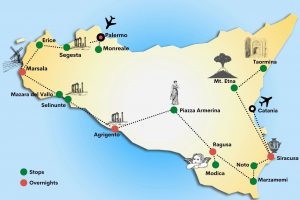 We simply can’t imagine a better way to immerse yourself in the life of Sicily without a company like us, to explore hidden corners and appreciate nuances while enjoying the benefits and enormous satisfaction of traveling under your own power.
We simply can’t imagine a better way to immerse yourself in the life of Sicily without a company like us, to explore hidden corners and appreciate nuances while enjoying the benefits and enormous satisfaction of traveling under your own power.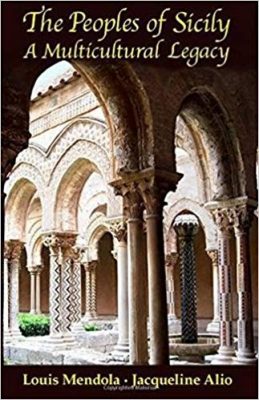 The Peoples of Sicily Book
The Peoples of Sicily Book


